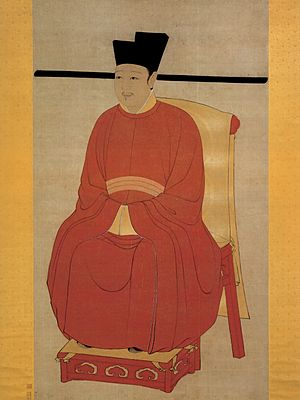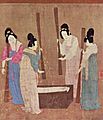Emperor Huizong of Song facts for kids
Quick facts for kids Emperor Huizong of Song宋徽宗 |
|||||||||||||||||
|---|---|---|---|---|---|---|---|---|---|---|---|---|---|---|---|---|---|

Palace portrait of Emperor Huizong, on a hanging scroll, kept in the National Palace Museum, Taipei, Taiwan
|
|||||||||||||||||
| Emperor of the Song dynasty | |||||||||||||||||
| Reign | 23 February 1100 – 18 January 1126 | ||||||||||||||||
| Coronation | 23 February 1100 | ||||||||||||||||
| Predecessor | Emperor Zhezong | ||||||||||||||||
| Successor | Emperor Qinzong | ||||||||||||||||
| Born | Zhao Ji (趙佶) 7 June 1082 Bianliang, Song dynasty (present-day Kaifeng, Henan) |
||||||||||||||||
| Died | 4 June 1135 (aged 52) Wuguocheng, Jin dynasty (present-day Yilan County, Heilongjiang) |
||||||||||||||||
| Burial | 1142 Yongyouling Mausoleum (永祐陵, in present-day Shaoxing, Zhejiang) |
||||||||||||||||
| Consorts |
Empress Xiangong
(died 1108)Empress Xiansu
(died 1131)Empress Mingda
(died 1113)Empress Mingjie
(died 1121)Empress Xianren
(before 1135) |
||||||||||||||||
| Issue | See § Family | ||||||||||||||||
|
|||||||||||||||||
| House | House of Zhao | ||||||||||||||||
| Father | Emperor Shenzong | ||||||||||||||||
| Mother | Empress Qinci | ||||||||||||||||
| Signature |  |
||||||||||||||||
| Emperor Huizong of Song | |||||||
|---|---|---|---|---|---|---|---|
| Chinese | 宋徽宗 | ||||||
| Literal meaning | "Fine/beautiful Ancestor of the Song" | ||||||
|
|||||||
| Zhao Ji | |||||||
| Traditional Chinese | 趙佶 | ||||||
| Simplified Chinese | 赵佶 | ||||||
|
|||||||
| Duke Hunde | |||||||
| Chinese | 昏德公 | ||||||
| Literal meaning | Besotted Duke | ||||||
|
|||||||
Emperor Huizong of Song (born Zhao Ji) was an important emperor of the Northern Song dynasty in China. He was born on June 7, 1082. He became emperor in the year 1100. This happened after his older brother, Emperor Zhezong, passed away. Emperor Zhezong did not have any sons who lived long enough to take the throne.
Huizong was known for his love of art, poetry, and music. He was also a talented calligrapher. However, his reign ended in a difficult time for China. In 1126, a group called the Jurchens invaded the Song dynasty. They were from the Jin dynasty.
Because of the invasion, Emperor Huizong gave up his throne to his oldest son, Zhao Huan. Zhao Huan then became Emperor Qinzong. Huizong took the special title of Taishang Huang, which means "Retired Emperor."
The next year, the Song capital city, Bianjing, was captured by the Jin forces. This event is known as the Jingkang Incident. Emperor Huizong, Emperor Qinzong, and their families were taken captive. They were brought to the Jin capital. The Jurchen ruler gave Huizong a humiliating title, "Duke Hunde," which means "Besotted Duke."
One of Huizong's sons, Zhao Gou, managed to escape capture. He later became the first emperor of the Southern Song dynasty. The Jurchens used Huizong and Qinzong to try and pressure Zhao Gou to surrender. Emperor Huizong died in captivity in 1135, after about nine years as a prisoner. He was 52 years old.
Even though he faced challenges as a ruler, Emperor Huizong was famous for his artistic skills. He loved Taoism and was talented in poetry, painting, calligraphy, and music. He supported many artists at his royal court. His art collection included over 6,000 paintings!
Contents
Life as an Emperor and Artist
Emperor Huizong was a very cultured leader. He spent much of his time enjoying the arts. He collected paintings, calligraphy, and old treasures from past dynasties. He built huge collections of these items.
He also wrote his own poems and was a skilled painter. He even created his own unique style of calligraphy. Huizong was interested in architecture and garden design. He also wrote books about medicine and Taoism.
He brought together many talented painters to work at his imperial court. They had to pass an exam to become official court artists. He also made changes to court music. Many people believe he was one of the greatest Chinese artists ever.
In 1106, he had special Nine Tripod Cauldrons made. These were symbols of his power and authority. However, his decisions about foreign policy led to big problems for the Song Empire.
The Jurchen Invasion Begins
The Jurchens started their own empire, the Jin Dynasty. They attacked the Liao dynasty to the north of the Song. In 1122, the Song dynasty decided to team up with the Jin Dynasty. They attacked the Liao from the south.
The Song army, led by Tong Guan, marched to the border. They had to clear a protective forest that the Song had kept for a long time. This attack helped destroy the Liao dynasty, which had been an enemy of the Song for many years.
However, this alliance did not last. A few years later, the Jin attacked the Song dynasty. The Jin troops marched through the now unprotected border. They quickly surrounded the Song capital, Kaifeng.
Giving Up the Throne
The Jin Dynasty became a very strong enemy on the northern border. They were not happy with just taking over the Liao lands. They saw that the Song army was weak. So, the Jurchens soon declared war on their former ally.
By early 1126, Jin troops were close to Bianjing, the Song capital. Emperor Huizong realized his mistakes. He was filled with panic and wanted to run away. His officials convinced him to give up his throne first.
Huizong pretended to have a stroke. He said he was afraid of chaos breaking out. On January 18, 1126, he gave his throne to his oldest son, Zhao Huan. Zhao Huan became known as Emperor Qinzong.
Qinzong did not want to be emperor. He even pushed away the royal robes. Huizong, still pretending to be sick, wrote with his left hand, "If you do not accept, you are not a good son." Qinzong replied, "If I accept, then I am not a good son." Huizong finally ordered his eunuchs to force Qinzong onto the throne. Qinzong eventually accepted. Huizong then left the capital to hide in the countryside.
Capture and Captivity
It was hard for the Jurchen cavalry to break through Bianjing's walls. Some Song officials fought bravely. Emperor Qinzong also gave them a town. Because of this, the Jurchens stopped their attack on Bianjing and went back north.
The Song Empire had to sign a humiliating peace treaty with the Jin Empire. They agreed to pay a huge amount of money and give gifts to the Jurchens every year. From 1126 to 1138, many people from the Song Empire moved south. They went towards the Yangtze River. Huizong returned to the capital after the siege was lifted. However, he was essentially under house arrest by Qinzong.
But even these harsh terms could not save the Song dynasty. Within a few months, the Jurchen armies returned. This time, they were determined to capture Bianjing. This happened after Qinzong tried to make an alliance against the Jin with two Liao nobles. These nobles were actually on the Jurchens' side.
After a difficult siege, the Jurchens finally entered Bianjing on January 9, 1127. Many days of looting and killing followed. Most of the royal court and family were captured by the Jurchens. This event is known as the Jingkang Incident. They were taken north to the Jin capital.
After Qinzong was captured, Emperor Huizong was convinced to surrender. He was also captured. When Huizong saw Qinzong, they cried and hugged. Huizong said, "If you had listened to the old man, we would have avoided this disaster."
One of Emperor Huizong's sons, Zhao Gou, was not in Bianjing. He had gone to Southern China. After many years of struggle, he would establish the Southern Song dynasty. He became its first ruler, Emperor Gaozong.
The Jurchens lowered the rank of Emperors Huizong and Qinzong to commoners on March 20, 1127. Then, on May 10, 1127, Emperor Huizong was sent to Heilongjiang. He spent the last eight years of his life there as a prisoner. In 1128, in a very humiliating moment, the two former Song Emperors had to honor the Jin ancestors. They had to wear special mourning clothes. The Jurchen ruler gave them insulting titles. Emperor Huizong was called "Duke Hunde" (meaning "Besotted Duke"). Emperor Qinzong was called "Marquis Chonghun" (meaning "Doubly Besotted Marquis").
The captured Song princes were given Khitan women to marry. These women were from the Liao dynasty palace. The Jin Jurchens had also defeated the Khitan people. The original Chinese wives of the Song princes were taken away. They were replaced with Khitan wives. The Jin Jurchens kept giving new wives to the captured Song royals. They told the Chinese Song royals that they were lucky. They said the Liao Khitan royals were treated much worse.
In 1137, the Jin Empire told the Southern Song Empire that Emperor Huizong had died. Emperor Huizong had lived a life of luxury and art in his early years. He died a broken man in northern Heilongjiang in June 1135, at age 52.
A few years later, during peace talks between the Jin and Song empires, the Jin Empire gave Huizong a new title. He was called "Prince of Tianshui Commandery." This was a more neutral title.
Art, Calligraphy, Music, and Culture
Emperor Huizong was a very talented painter, poet, and calligrapher. He also played the guqin, a Chinese musical instrument. His famous painting Listening to the Qin shows this. He even had a "10,000 Qin Hall" in his palace.
The emperor worked hard to find the best artists. He created the "Hanlin Imperial Painting House." This was a place where top painters in China could share their best works.
His paintings often showed birds and flowers. One of his famous works is Five-Colored Parakeet on Blossoming Apricot Tree. He also copied an older painting called Court Ladies Preparing Newly Woven Silk. Huizong's copy is the only one that still exists today.
Emperor Huizong created a unique calligraphy style called "Slender Gold." The name comes from how his writing looked like thin, twisted gold threads. It was also inspired by another artist's style called "Golden Inlaid Dagger."
One of the emperor's era names, Xuanhe, is also used to describe a way of mounting paintings. In this style, black borders are added between some of the silk parts of a scroll.
In 1114, the ruler of Goryeo (present-day Korea) asked for musical instruments. Emperor Huizong sent a set of instruments for royal banquets. Two years later, in 1116, he sent an even larger gift of 428 musical instruments. These were yayue instruments, which started the tradition of aak music in Goryeo.
Emperor Huizong was also a big fan of tea. He wrote a book called the Treatise on Tea. This book gives a very detailed description of the fancy Song style of tea ceremony.
A famous descendant of Emperor Huizong was Zhao Mengfu, through his daughter Zhao Jinluo.
Legacy
The painter Zeng Fanzhi greatly admires Huizong's painting Listening to the Qin. He calls it "the most beautiful painting from the Song dynasty." He has studied the pine tree in that painting for over 10 years.
Family
Emperor Huizong had many consorts and children. His first son, Zhao Huan, became Emperor Qinzong. Another son, Zhao Gou, was able to escape capture by the Jurchens. He later founded the Southern Song dynasty and became Emperor Gaozong.
Images for kids
See also
 In Spanish: Song Huizong para niños
In Spanish: Song Huizong para niños










